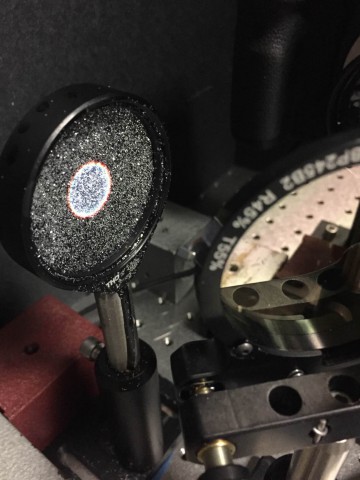The idea comes from researchers at NASA’s Jet Propulsion Laboratory in Pasadena, Calif. Instead of mirrors, the space telescope would use clouds of glitter-like particles. A small cloud of the particles would be trapped and manipulated by multiple laser beams.

“It’s a floating cloud that acts as a mirror,” said Marco Quadrelli from JPL, the Orbiting Rainbows principal investigator. “There is no backing structure, no steel around it, no hinges; just a cloud.”
Pressure from the laser light traps the particles; specifically, the momentum of photons translates into two forces: one that pushes particles away, and another that pushes the particles toward the axis of the light beam. As a result, the pressure, coming from different directions, shapes the cloud and pushes all the particles in the same direction. The cloud would be composed of millions of such grains, each one only a fraction of a millimeter in diameter. This “dust cloud” would essentially act as the mirror for the telescope. In addition, this kind of telescope would have a wide, adjustable aperture, possibly even larger than other space telescopes.
Such a telescope would be easier to package, transport, and deploy than a conventional space telescope, such as Kepler.
“You deploy the cloud, trap it and shape it,” Quadrelli said.
The idea for the telescope first originated in 1979, in a paper by astronomer Antoine Labeyrie at the College de France in Paris.
The kind of “granular matter” used, including dust grains, powders, and aerosols, are very light, can be produced at low-cost, and therefore could be useful to the space exploration community. For Orbiting Rainbows, the “glitter” may be tiny granules of metallic-coated plastic, quartz, or some other material.

The name “Orbiting Rainbows” is derived from the fact that phenomena such as rainbows, optical phenomena in clouds, or comet tails also have light-scattering and focusing properties.
One seeming problem, however, is that a cloud of dust particles is not a smooth surface, which would result in noisier images. So how to fix that? To compensate, researchers are developing algorithms to take multiple images and computationally remove the speckle effect from the glitter. This is already being tested now; co-investigator Grover Swartzlander, an associate professor at the Rochester Institute of Technology in New York, and his students spread glitter on a concave lens in the laboratory. They then used lasers to represent the light from a double star system. They pointed the speckled mirror at the simulated stars, then used a camera to take pictures. After many exposures and a lot of processing, an image of the two “stars” emerged using the glitter mirror.
“This is a major achievement,” Quadrelli said. “This demonstrates a highly controlled experiment in which we were able to do imaging in the visible light spectrum.”
However, it hasn’t been tested in space yet. To do that, astronomers will need to deploy a small telescope in low-Earth orbit, along with a small patch of particles about the size of a bottle cap. Later, astronomers will make many of these patches and synthesize an aperture with which to do imaging. The JPL optical design team, including Scott Basinger and Mayer Rud, is already working on the adaptive optics techniques that would be needed by the Orbiting Rainbows telescope.

There are other possible applications of the Orbiting Rainbows telescope, such as earthquake detection and remote sensing of water and other phenomena. This is due to the fact that the radio wavelength used is much longer (about one centimeter), compared to nanometers in visible light; the mirror grains don’t have to be as precisely controlled or aligned. Darmindra Arumugam at JPL is currently investigating possible mechanisms for remote sensing.
Orbiting Rainbows is currently in Phase II development through the NASA Innovative Advanced Concepts (NIAC) Program; it was one of five technology proposals chosen for continued study in 2014. Currently, researchers are conducting small-scale ground experiments to demonstrate how granular materials can be manipulated using lasers and to simulate of how the imaging system would behave in orbit. NIAC is a program of NASA’s Space Technology Mission Directorate, located at the agency’s headquarters in Washington.
Orbiting Rainbows would provide a unique opportunity in the quest to further search for and image exoplanets. Only a few exoplanets have been directly photographed so far, such as Beta Pictoris b. Although they are being discovered by the thousands using various techniques, obtaining direct images of exoplanets is still difficult and in its early stages. Orbiting Rainbows would be a significant step in being able to actually see more of these worlds orbiting other stars, even if they would be little more than dots of light, given the immense distances to them.
Want to keep up-to-date with all things space? Be sure to “Like” AmericaSpace on Facebook and follow us on Twitter: @AmericaSpace




Pretty wild. I don’t know what to say about it. I know fusion energy is basically a cover for weapons research. I know the superconductor revolution never happened. And I know there is a plethora of nutty projects money is being spent on like reusing rocket stages, and hyperloopy gimmicks like 4000 cheap and nasty little shoebox satellites zooming overhead. So forgive me if I am skeptical of NASA “concepts” after some other press releases concerning cloud cities on Venus and astronauts with light sabers were released. Very bad that NASA is allowing their brand on some of this garbage. But…who knows, maybe a telescope made of fairy dust might work.